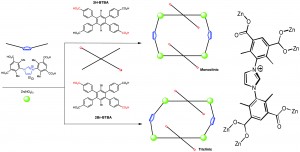Metal organic frameworks (MOFs) are porous materials with a high surface area. This makes them useful for processes such as catalysis and gas storage, including hydrogen storage, which is crucial for environmentally friendly energy applications.
Nevertheless, many MOF structures can only hold onto H2 molecules at very low temperatures and concentrations. To enable the MOF to hold onto H2 molecules at higher temperatures and concentrations, Lalonde and colleagues have synthesized MOFs with a zwitterionic structure, where the negatively charged Zn2(CO2)5 groups are separated from the positive imidazole tetra acid groups. The material shows enhanced H2 adsorption, and is a good candidate for further optimisation. The zwitterionic design can also be applied to synthesizing other MOF structures or porous materials for use in H2 storage.
Read their article to find out more:
A zwitterionic metal–organic framework with free carboxylic acid sites that exhibits enhanced hydrogen adsorption energies
Marianne B. Lalonde, Rachel B. Getman, Jeong Yong Lee, John M. Roberts, Amy A. Sarjeant, Karl A. Scheidt, Peter A. Georgiev, Jan P. Embs, Juergen Eckert, Omar K. Farha, Randall Q. Snurr and Joseph T. Hupp
CrystEngComm, 2013, Advance Article
DOI: 10.1039/C3CE40198G











